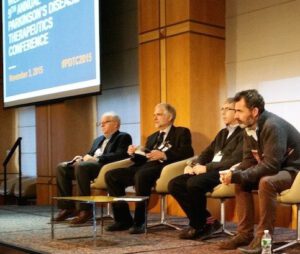
The panel discussing Parkinson’s Progression Marker Initiative at the MJFF’s Parkinson’s Disease Therapeutics Conference in New York.
From implanting cells into the brain to prevent the loss of dopamine producing nerve cells, to placing light sensitive channels in nerve cells to better treat the symptoms of Parkinson’s disease, researchers are pushing into new realms in the fight against the disease.
At the ninth annual Michael J. Fox Foundation Parkinson’s Therapeutics Conference in New York City earlier this month, more than 300 gathered to learn about a wide range of new experimental treatments and therapies.
Always groundbreaking, this year’s conference didn’t disappoint, and offered attendees much to be optimistic about. 23andMe’s Paul Cannon, Ph.D., who manages our Parkinson’s Research Community, was there along with Linda Yu, Ph.D., a project manager in business development here, and other business leaders, researchers and scientists.
“This was my second year attending the conference and I continue to be impressed by what I see,” said Paul. “It’s also a great opportunity to meet with like-minded researchers all interested in one thing – finding new breakthroughs in the fight against Parkinson’s.”

Paul Cannon, Ph.D., 23andMe’s Parkinson’s Research Community manager.
Bringing together the foundation’s partners and grantees, the annual conference is meant to offer a snapshot of the state of the science around the study of Parkinson’s and its treatments. The daylong conference is broken into sessions that focus on treatments that can modify the progression of the disease, or those that treat the symptoms, as well as sessions that focus on what’s on the horizon, and new tools that can be used in Parkinson’s research.
There was a lot packed into one day, but Paul singled out a few presentations that he found particularly interesting.
The first is a treatment that is now in the preclinical phase, a first step in the process of drug development. The treatment involves an innovative technique that implants cells into the brain. Those cells are engineered to express glial derived neurotrophic factor (GDNF), a protein that could help prevent or even reverse the loss of dopamine producing neurons due to Parkinson’s. Dopamine acts as a neurotransmitter in the brain and helps individuals regulate their movements, their body and emotions even. There is still much to be done, and an important next step in the process is a planned clinical study next year, the purpose of which is to make sure that this therapy can be safely administered to patients.
Paul was also struck by the unusual cooperation between three competing drug companies and The Michael J. Fox Foundation. The companies – Genentech, Pfizer and Merck – are all developing inhibitors of the LRRK2 kinase, the product of the well-known LRRK2 gene, mutations in which cause Parkinson’s disease in some individuals. An exciting feature of this approach is that it may also help all Parkinson’s patients, not just those with the deleterious LRRK2 mutations. The consortium members, led by the foundation, are sharing their compounds and data to work through safety concerns and understand the potential impact of this approach on lung function, which was discovered during animal models.
“This is a cool and rare example of cross-company collaboration,” said Paul. “The Michael J. Fox Foundation did well to pull it off.”

Linda Yu, Ph.D., a 23andMe project manager in business development.
There were many other interesting new therapies, such as the use of optogenetics in the treatment of Parkinson’s symptoms. This involves placing light sensitive channels in nerve cells and then stimulating them with light to open or close those channels as a way to treat certain symptoms of the disease. Paul said there were also many updates on other treatments in development for Parkinson’s including better techniques for administering the drug Levodopa in order to minimize the development of drug induced dyskinesias (abnormal involuntary movements).
Beyond drug development the conference also included presentations on new ways to detect Parkinson’s and monitor its progression, as well as interesting new uses for smartphones. Dr. Ray Dorsey, a researcher at the University of Rochester who has worked with 23andMe as a member of our Parkinson’s Research Scientific Advisory Board, spoke about the potential of using smartphones as an unobtrusive way to monitor the symptoms and progression of Parkinson’s in patients. Motion sensors in the phones apps that can measure changes in changes in gait, or voice monitors that can measure changes in the tone of voice, are likely to be the next big tool for those treating people with Parkinson’s. Working with researchers at Harvard and the company Sage Bionet, researchers have already developed two applications that leverage smartphone technology. This is also helping researchers who are collecting survey data and gathering patient feedback.
“It’s a fascinating area,” said Paul “The key is to collect data with a view to the questions you are trying to address otherwise drowning in data is a real possibility.”



